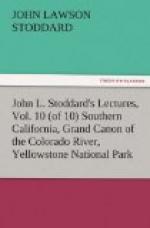[Illustration: SOME OF THE CANON TEMPLES.]
[Illustration: SIVA’S TEMPLE.]
It is difficult to realize the magnitude of these objects, so deceptive are distances and dimensions in the transparent atmosphere of Arizona. Siva’s Temple, for example, stands upon a platform four or five miles square, from which rise domes and pinnacles a thousand feet in height. Some of their summits call to mind immense sarcophagi of jasper or of porphyry, as if they were the burial-places of dead deities, and the Grand Canon a Necropolis for pagan gods. Yet, though the greater part of the population of the world could be assembled here, one sees no worshipers, save an occasional devotee of Nature, standing on the Canon’s rim, lost in astonishment and hushed in awe. These temples were, however, never intended for a human priesthood. A man beside them is a pygmy. His voice here would be little more effective than the chirping of an insect. The God-appointed celebrant, in the cathedrals of this Canon, must be Nature. Her voice alone can rouse the echoes of these mountains into deafening peals of thunder. Her metaphors are drawn from an experience of ages. Her prayers are silent, rapturous communings with the Infinite. Her hymns of praise are the glad songs of birds; her requiems are the meanings of the pines; her symphonies the solemn roaring of the winds. “Sermons in stone” abound at every turn; and if, as the poet has affirmed, “An undevout astronomer is mad,” with still more truth can it be said that those are blind who in this wonderful environment look not “through Nature up to Nature’s God.” These wrecks of Tempest and of Time are finger-posts that point the thoughts of mortals to eternal heights; and we find cause for hope in the fact that, even in a place like this, Man is superior to Nature; for he interprets it, he finds in it the thoughts of God, and reads them after Him.




